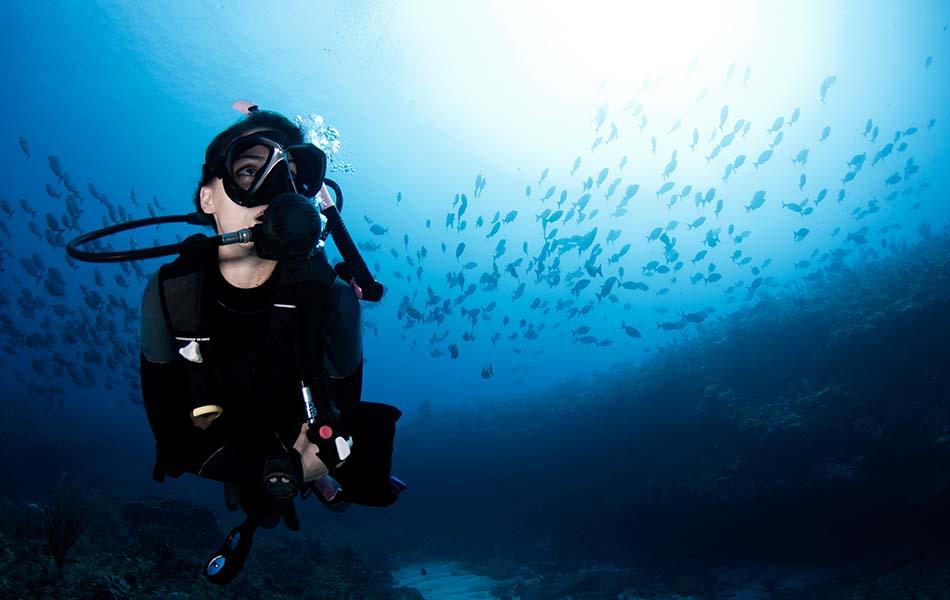
Dr Ashley Davies of DDRC Healthcare considers the function of our blood vessels and the implications of high blood pressure for safe diving.
Blood is pumped around our bodies through blood vessels and these can be broadly split into three categories. Firstly, the arteries – with thick elastic walls, they carry high-pressure oxygenated blood from the heart to the various tissues of the body. As blood travels along them, their walls stretch and rebound to help smooth out the ‘pulse’ into a continuous flow. These vessels branch and divide, getting progressively smaller until we reach the capillaries.
The capillaries form an extensive network of tiny vessels in every tissue of the body, supplying them with essential oxygen and nutrients before removing waste products. Their walls are only one-cell thick to minimise the distance over which these products must travel as they move into – and out of – the blood.
After leaving their target tissues, the capillaries re-join to become large vessels once more – the veins. Veins carry low pressure, deoxygenated blood back to the heart (and the start of this cycle). They contain a series of one-way valves. As we move, our muscles contract and squeeze blood along the veins towards the heart. The valves stop the blood flowing backwards, aiding its journey and stopping the blood pooling in the limbs. It is the failure of these valves that leads to varicose veins.
Hypertension – what is it?
Blood pressure (BP) refers to the pressure, or tension, the blood exerts on the arteries. It is measured using two values, recorded one over the other. The larger top value is the systolic blood pressure, which corresponds to the pressure inside the vessels when the heart is actively pumping blood out. The lower value is the diastolic blood pressure, the pressure in the vessels when the heart is ‘resting’ between beats. Normal BP is 120/80mmHg.
Hypertension is the medical term for high blood pressure (a blood pressure 140/90mmHg or greater). It affects more than 1 in 4 adults in the UK and puts us at risk of having a heart attack or stroke. Hypertension can also lead to kidney disease, heart failure and, in men, erectile dysfunction. All of these conditions are serious but a particularly unique concern for divers is immersion pulmonary oedema (IPO). This causes sudden onset breathing difficulty and can be fatal.
What if I am concerned about my blood pressure?
You should make an appointment for it to be checked with your local pharmacy or GP surgery. If it is raised your GP will arrange for further measurements to be taken, to confirm hypertension, before prescribing an appropriate treatment.
Treatments
Firstly, we should consider lifestyle measures. These may be used instead of, or in addition to, medications. Such measures include; weight loss, reducing dietary salt and alcohol, exercising frequently and stopping smoking.
If making these changes don’t improve your blood pressure, then medication should be considered. The initial treatment chosen will depend on a variety of factors, including your age and ethnicity. Many, but not all, drugs are fine to dive with. Drugs which don’t slow the heart are generally preferred – often drugs such as Amlodipine or one of the ‘ACE inhibitors’ are best for divers. However, it’s important to find the right drug for you. You will likely need a dive medical after this, where a diving doctor will chat to you about how this will impact your diving.
Lots of people continue to dive safely once they are on treatment for hypertension. It’s much safer for divers to have their BP checked and to start treatment than to be diving with high blood pressure.
So, after reading this article I hope you agree that it’s a good idea as a diver to get your blood pressure checked periodically and that if you do have hypertension then it’s far better to be treated than not!
Interested in diving health and medicine?
This column is produced with DDRC Healthcare, specialists in diving and hyperbaric medicine. You can find out more on their website.
This Anatomy of a diver column was originally published in SCUBA magazine, Issue 101 April 2020. For more membership benefits, visit bsac.com/benefits.
Images in this online version may have been substituted from the original images in SCUBA magazine due to usage rights.

 Author: DDRC Healthcare | Posted 08 Aug 2020
Author: DDRC Healthcare | Posted 08 Aug 2020



